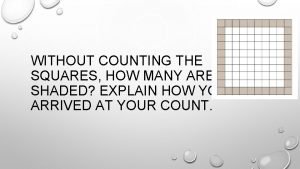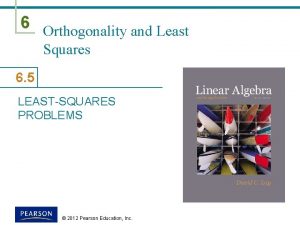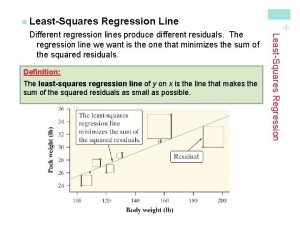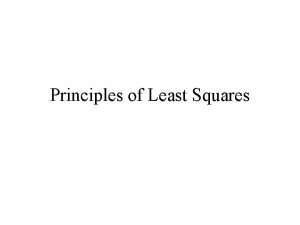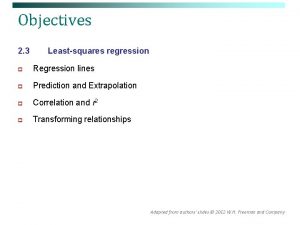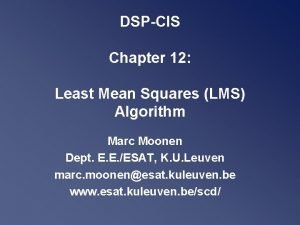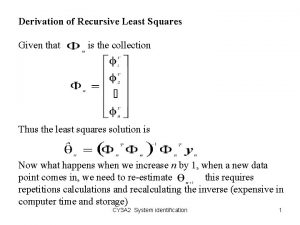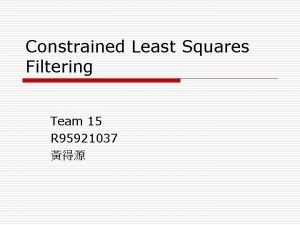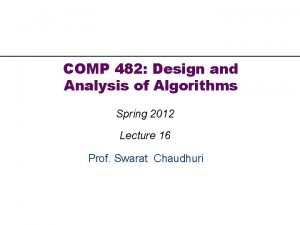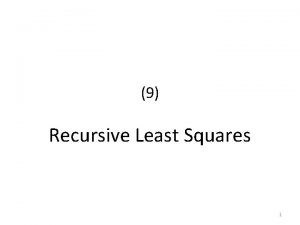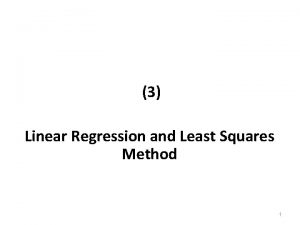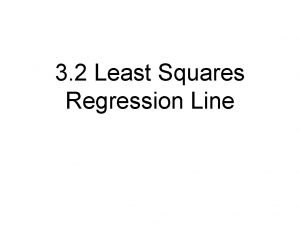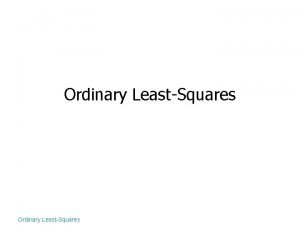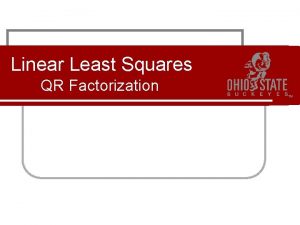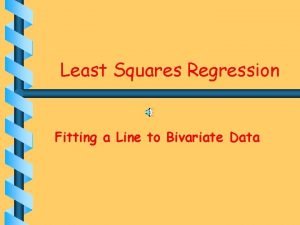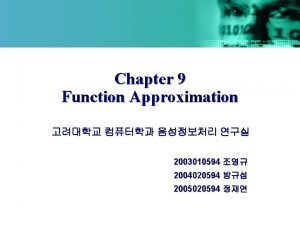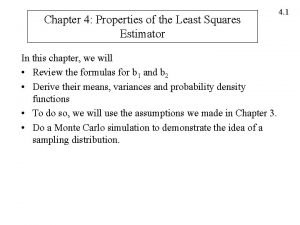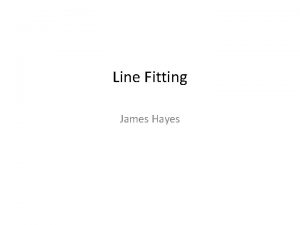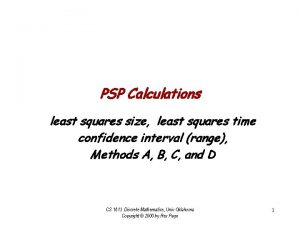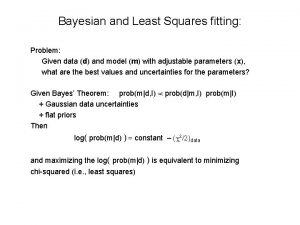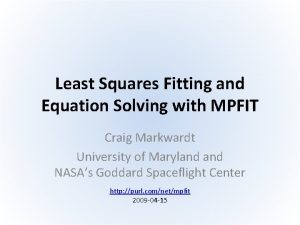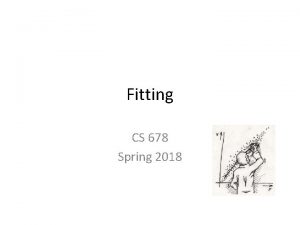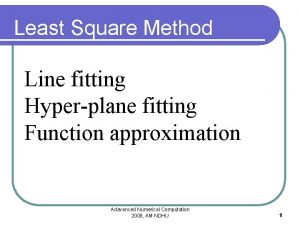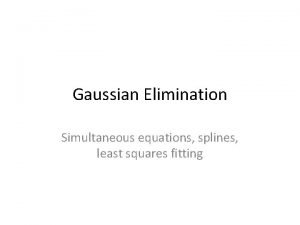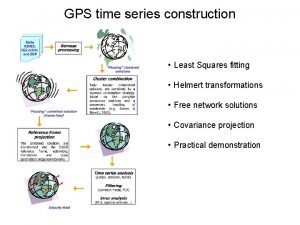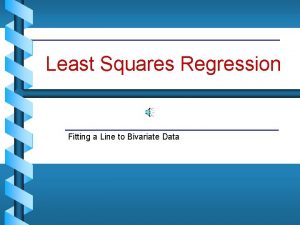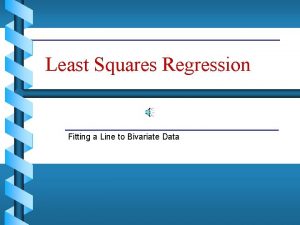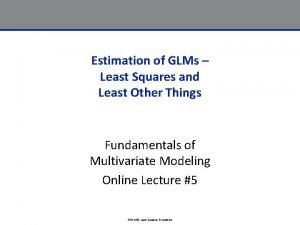Data Modeling and Least Squares Fitting 2 COS



















- Slides: 19

Data Modeling and Least Squares Fitting 2 COS 323

Nonlinear Least Squares • Some problems can be rewritten to linear • Fit data points (xi, log yi) to a*+bx, a = ea* • Big problem: this no longer minimizes squared error!

Nonlinear Least Squares • Can write error function, minimize directly • For the exponential, no analytic solution for a, b:

Newton’s Method • Apply Newton’s method for minimization: where H is Hessian (matrix of all 2 nd derivatives) and G is gradient (vector of all 1 st derivatives)

Newton’s Method for Least Squares • Gradient has 1 st derivatives of f, Hessian 2 nd

Gauss-Newton Iteration • Consider 1 term of Hessian: • If close to answer, first term close to 0 • Gauss-Newtion method: ignore first term! – Eliminates requirement to calculate 2 nd derivatives of f – Surprising fact: still superlinear convergence if “close enough” to answer

Levenberg-Marquardt • Newton (and Gauss-Newton) work well when close to answer, terribly when far away • Steepest descent safe when far away • Levenberg-Marquardt idea: let’s do both Steepest descent Gauss. Newton

Levenberg-Marquardt • Trade off between constants depending on how far away you are… • Clever way of doing this: • If is small, mostly like Gauss-Newton • If is big, matrix becomes mostly diagonal, behaves like steepest descent

Levenberg-Marquardt • Final bit of cleverness: adjust depending on how well we’re doing – Start with some , e. g. 0. 001 – If last iteration decreased error, accept the step and decrease to /10 – If last iteration increased error, reject the step and increase to 10 • Result: fairly stable algorithm, not too painful (no 2 nd derivatives), used a lot

Outliers • A lot of derivations assume Gaussian distribution for errors • Unfortunately, nature (and experimenters) sometimes don’t cooperate probability Gaussian Non-Gaussian • Outliers: points with extremely low probability of occurrence (according to Gaussian statistics) • Can have strong influence on least squares

Robust Estimation • Goal: develop parameter estimation methods insensitive to small numbers of large errors • General approach: try to give large deviations less weight • M-estimators: minimize some function other than square of y – f(x, a, b, …)

Least Absolute Value Fitting • Minimize instead of • Points far away from trend get comparatively less influence

Example: Constant • For constant function y = a, minimizing (y–a)2 gave a = mean • Minimizing |y–a| gives a = median

Doing Robust Fitting • In general case, nasty function: discontinuous derivative • Simplex method often a good choice

Iteratively Reweighted Least Squares • Sometimes-used approximation: convert to iterated weighted least squares with wi based on previous iteration

Iteratively Reweighted Least Squares • Different options for weights – Avoid problems with infinities – Give even less weight to outliers

Iteratively Reweighted Least Squares • Danger! This is not guaranteed to converge to the right answer! – Needs good starting point, which is available if initial least squares estimator is reasonable – In general, works OK if few outliers, not too far off

Outlier Detection and Rejection • Special case of IRWLS: set weight = 0 if outlier, 1 otherwise • Detecting outliers: (yi–f(xi))2 > threshold – One choice: multiple of mean squared difference – Better choice: multiple of median squared difference – Can iterate… – As before, not guaranteed to do anything reasonable, tends to work OK if only a few outliers

RANSAC • RANdom SAmple Consensus: desgined for bad data (in best case, up to 50% outliers) • Take many random subsets of data – Compute least squares fit for each sample – See how many points agree: (yi–f(xi))2 < threshold – Threshold user-specified or estimated from more trials • At end, use fit that agreed with most points – Can do one final least squares with all inliers
 How many squares
How many squares Least squares matrix
Least squares matrix Helen c. erickson
Helen c. erickson My age
My age Least squares regression line definition
Least squares regression line definition Residual in surveying
Residual in surveying How to find least squares regression line on statcrunch
How to find least squares regression line on statcrunch Mean ?
Mean ? Recursive least squares derivation
Recursive least squares derivation Constrained least square filtering
Constrained least square filtering Segmented least squares dynamic programming
Segmented least squares dynamic programming Recursive least square method
Recursive least square method The least square method
The least square method Least squares regression line
Least squares regression line Nonlinear regression lecture notes
Nonlinear regression lecture notes Geometry of least squares
Geometry of least squares Qr factorization least squares
Qr factorization least squares Bivariate least squares regression
Bivariate least squares regression Approximation de padé
Approximation de padé Properties of least square estimator
Properties of least square estimator
